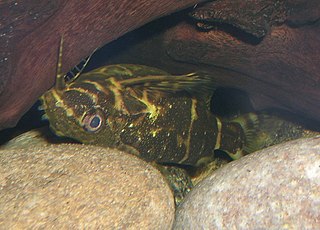Related Research Articles

Cobra is the common name of various venomous snakes, most of which belong to the genus Naja.

Noodling is fishing for catfish using one's bare hands or feet, and is practiced primarily in the southern United States. The noodler places their hand or foot inside a discovered catfish hole in order to catch the fish. Other names for the same activity are used in different regions, primarily in the South and Midwest, and include hogging, dogging, grappling, grabbling, and tickling.

Plecostomus, pleco, or plec is the common name of several species of freshwater loricariid catfish commonly sold as aquarium fish.
Hypostomus punctatus, the suckermouthed catfish, is a tropical fish belonging to the armored suckermouth catfish family, Loricariidae. Hypostomus punctatus is a freshwater fish native to South America, in the coastal drainages of southeastern Brazil and Uruguay. It is one of a number of species commonly referred to as "plecostomus" or "common pleco" by aquarists.

The walking catfish is a species of freshwater airbreathing catfish native to Southeast Asia. It is named for its ability to "walk" and wiggle across dry land, to find food or suitable environments. While it does not truly walk as most bipeds or quadrupeds do, it can use its pectoral fins to keep it upright as it makes a wiggling motion with snakelike movements to traverse land. This fish normally lives in slow-moving and often stagnant waters in ponds, swamps, streams, and rivers, as well as in flooded rice paddies, or temporary pools that may dry up. When this happens, its "walking" skill allows the fish to move to other aquatic environments. Considerable taxonomic confusion surrounds this species and it has frequently been confused with other close relatives. One main distinction between the walking catfish and the native North American ictalurid catfish with which it sometimes is confused, is that the walking catfish lacks an adipose fin. It can survive 18 hours out of water.

The common name dory is shared by members of several different families of large-eyed, silvery, deep-bodied, laterally compressed, and roughly discoid marine fish. As well as resembling each other, dories are also similar in habit: most are deep-sea and demersal. Additionally, many species support commercial fisheries as food fish. Most dory families belong to the order Zeiformes, suborder Zeioidei:
A bumblebee is a flying insect of the genus Bombus.

Panaque nigrolineatus, the royal panaque, royal plec, or royal pleco, is an herbivorous freshwater armored catfish native to Brazil, Colombia and Venezuela where it occurs in the Orinoco and Amazon basins. It is known for being one of the few fish that digest wood. They are arable to survive for a long period of time only on a wood-only, xylophagous diet. It grows to a length of 43.0 centimetres (16.9 in) and is a popular aquarium fish.
Armoured catfish may refer to:

The L-number system is a semi-scientific classification system of catfish based on photographs of shipments of tropical catfish of the family Loricariidae published by the German aquarium magazine DATZ. The first L-number was published in 1988.
Suckermouth catfish may refer to:
Bandit corydoras or bandit cory is a common name shared by two similar but distinct species of fish:
Barbel may refer to:

Hypancistrus is a genus of loricariid catfish originating from the Amazon basin in South America. Unlike many of the other Loricariids, however, some Hypancistrus species are more carnivorous and enjoy meat in their diet. Hypancistrus species are popular aquarium fish, including such popular fish as the zebra pleco and Queen Arabesque pleco.

The striped Raphael catfish is a catfish of the family Doradidae. It may also be called Southern striped Raphael, talking catfish, chocolate doradid, chocolate catfish or thorny catfish. It is native to the Amazon, Paraguay–Paraná and lower Orinoco basins in South America. This peaceful, nocturnal species is a popular aquarium fish due to its pleasant temperament and curious nature. Despite its name "talking catfish", it does not speak.
Raphael catfish may refer to a number of different South American doradid catfish species:

The name upside-down catfish is most commonly used by aquarists to refer to the mochokid catfish Synodontis nigriventris alternately known to ichthyologists as the blotched upside-down catfish or false upside-down catfish. However, a number of other fish may also be known by this name:
Pseudomystus is a genus of catfishes of the family Bagridae.
P. inornatus may refer to:
References
- "PlanetCatfish::Cat-eLog::Common Names". PlanetCatfish.com. Retrieved 2007-06-05.